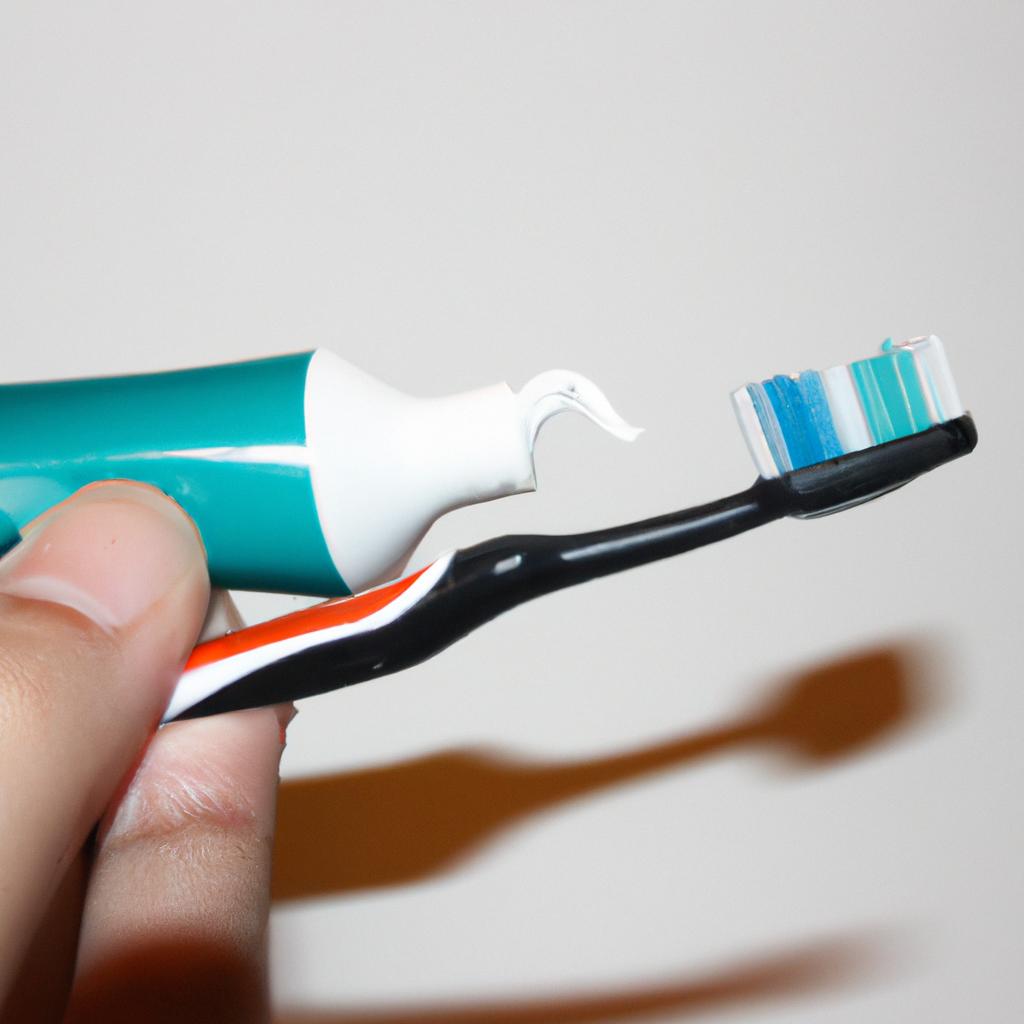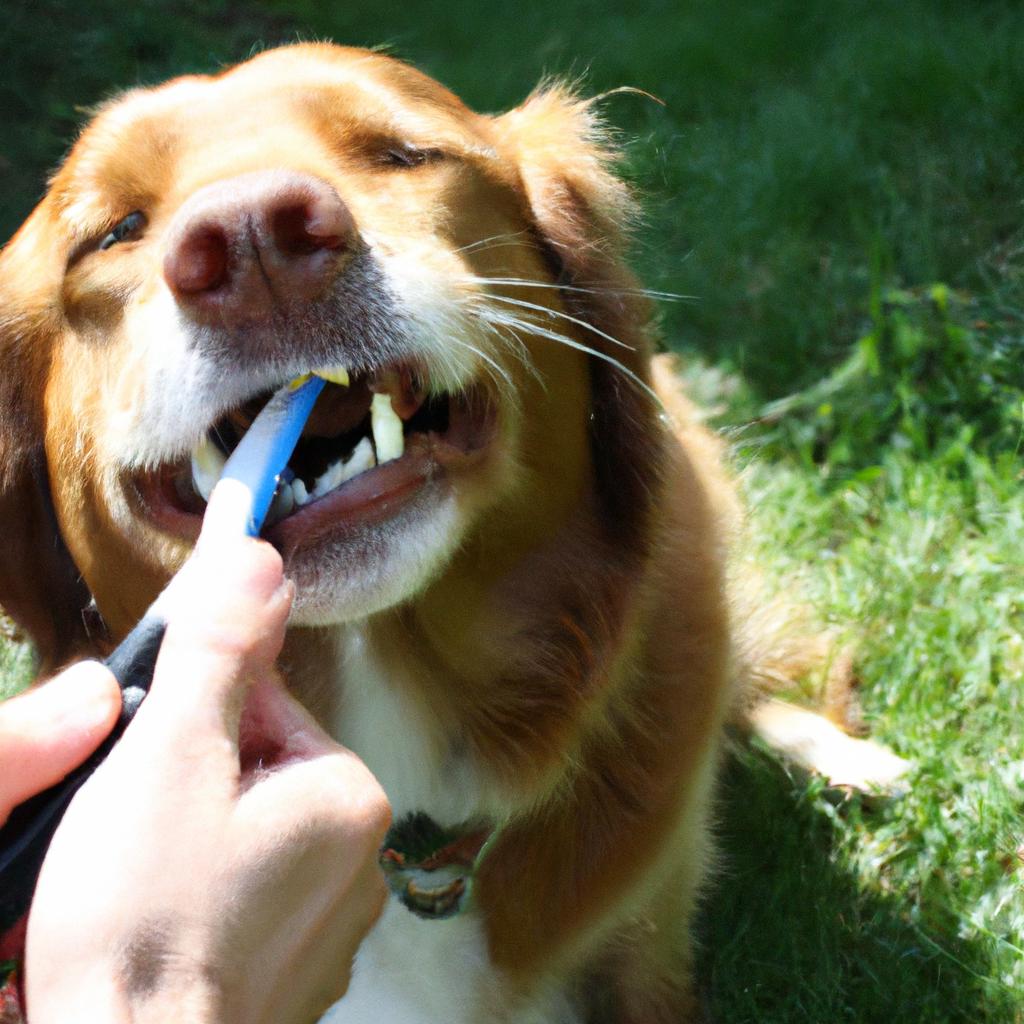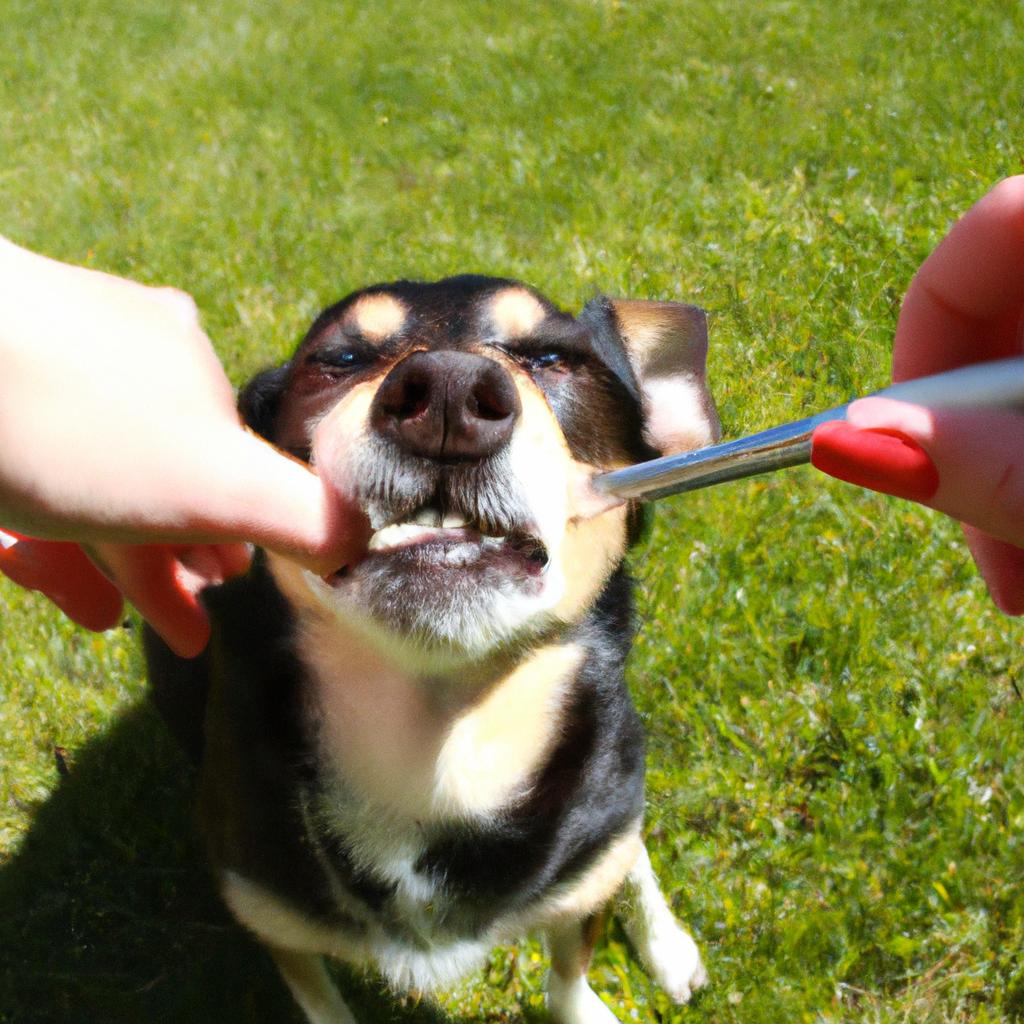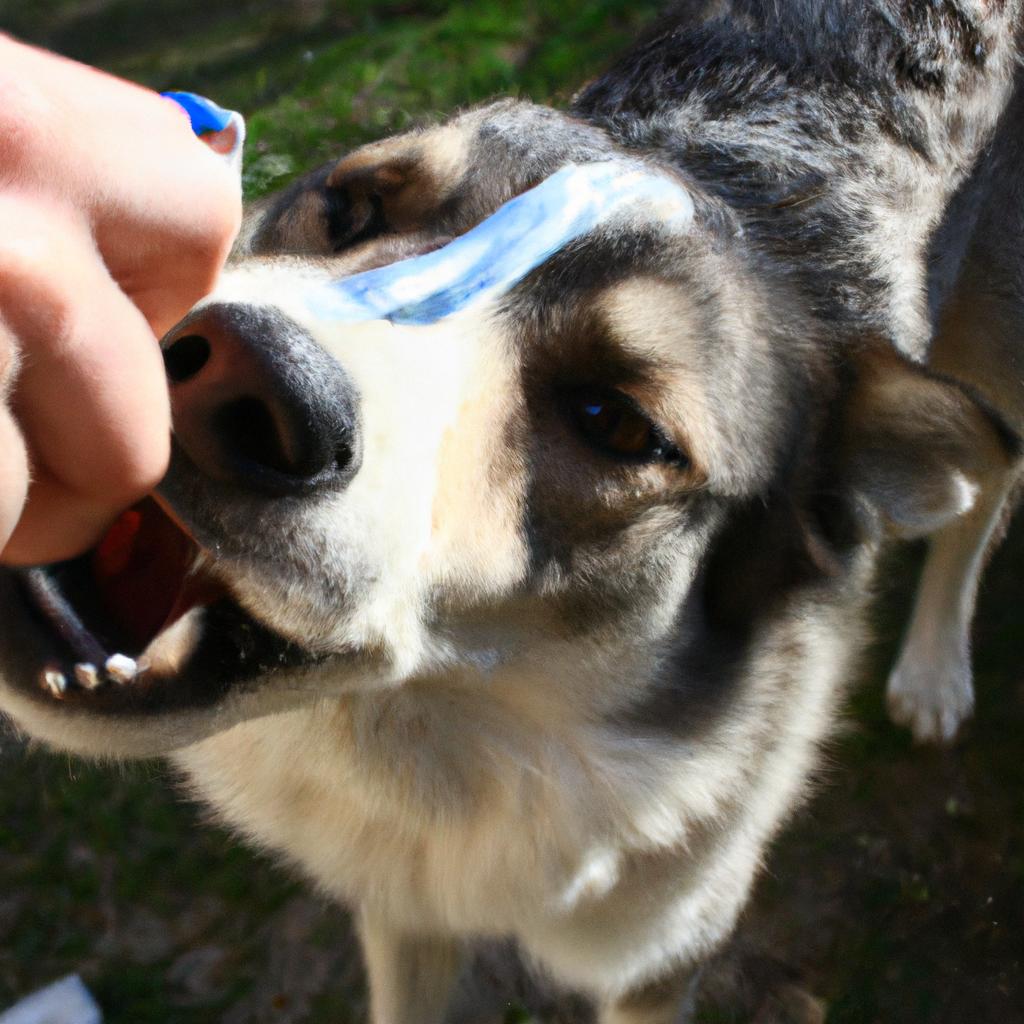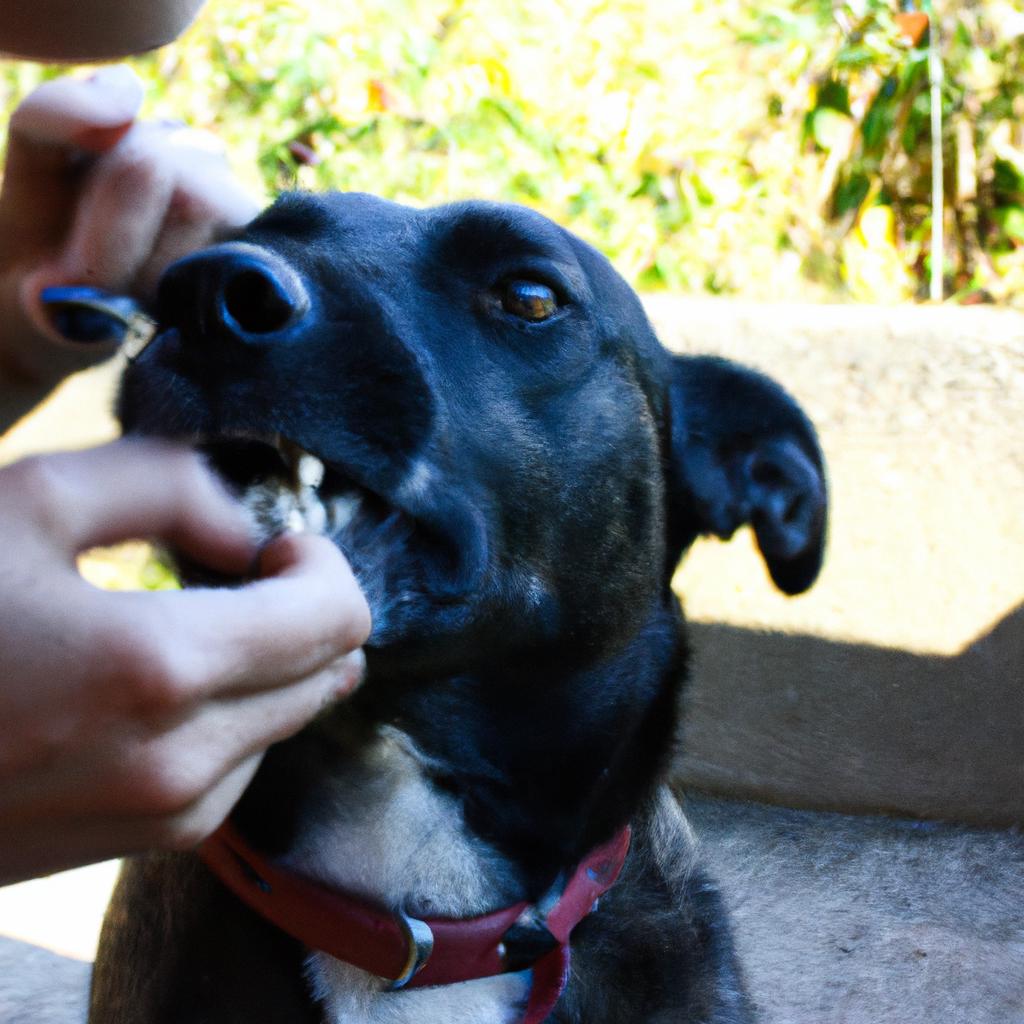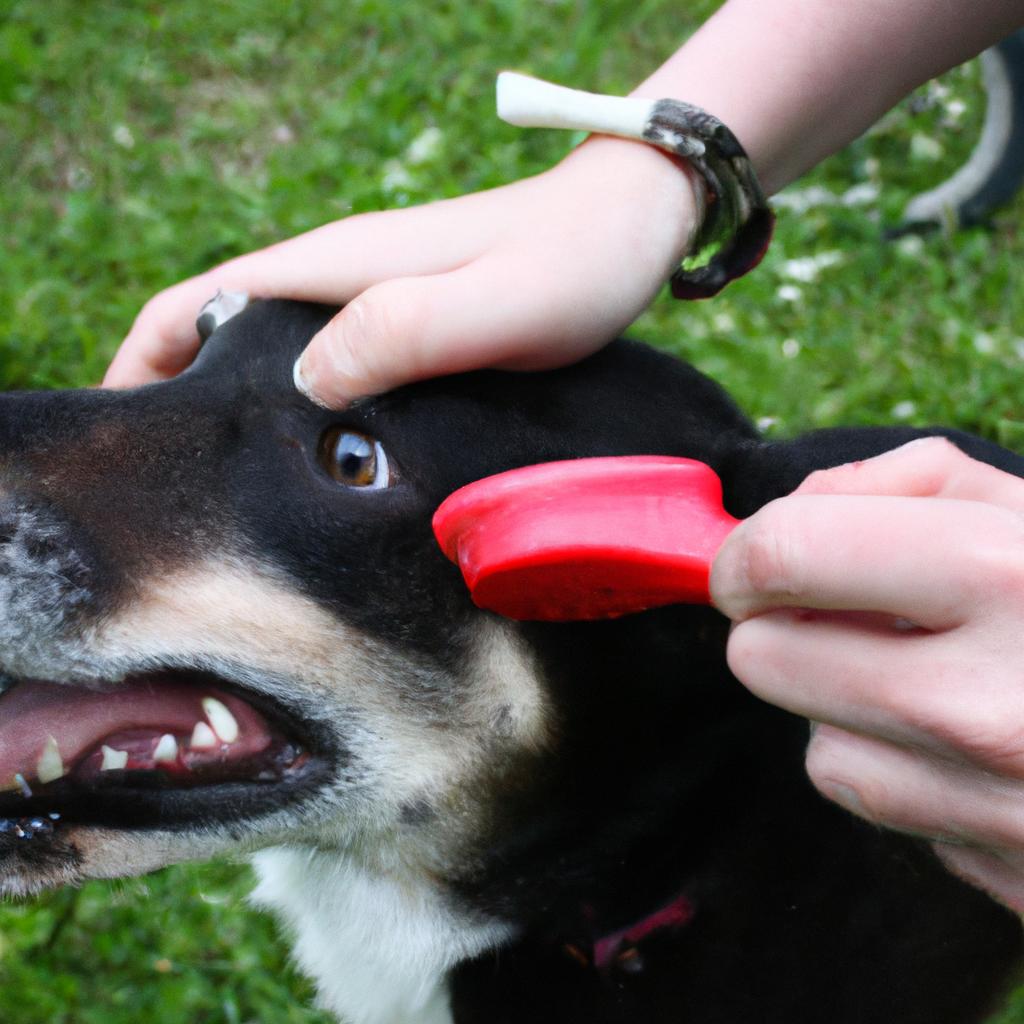Teeth Brushing for Dogs: Essential Grooming Information
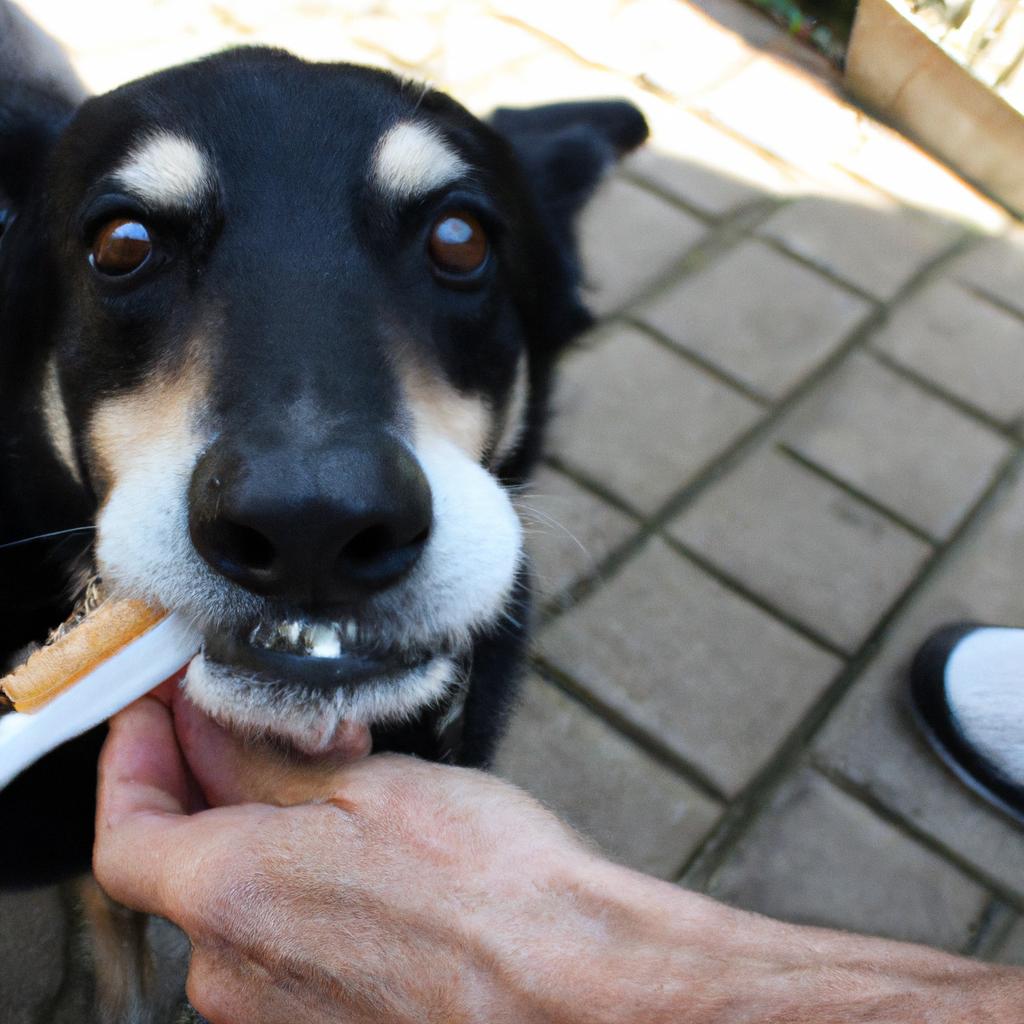
Teeth brushing is an essential aspect of grooming for dogs, ensuring their oral health and overall well-being. Just like humans, dogs are susceptible to dental issues such as plaque buildup, gum disease, and bad breath. Regular teeth brushing can help prevent these problems by removing food particles and bacteria that accumulate in the mouth. For instance, consider a hypothetical scenario where a dog owner neglects to brush their pet’s teeth regularly. Over time, this negligence could lead to the development of tartar on the dog’s teeth, causing discomfort and potentially leading to more severe dental issues.
Maintaining proper oral hygiene for dogs not only promotes healthy teeth but also helps prevent other potential health complications. Poor dental care can result in bacterial infections spreading from the mouth to other organs through the bloodstream. Furthermore, untreated dental issues may lead to pain while eating or chewing toys, which can affect a dog’s appetite and quality of life. By implementing Regular teeth brushing routines and providing appropriate chew toys, owners can ensure their furry companions enjoy good oral health throughout their lives.
In this article about “Teeth Brushing for Dogs: Essential Grooming Information,” we will explore various aspects of canine dental care. We will discuss the importance of regular teeth brushing and its impact on preventing common dental problems in dogs. Additionally, we will provide step-by-step instructions on how to brush your dog’s teeth effectively and safely.
It is crucial to choose the right toothbrush and toothpaste specifically formulated for dogs. Human toothpaste can be harmful to dogs as it may contain ingredients that are toxic to them. Dog-friendly toothpaste comes in flavors that appeal to dogs, making the brushing experience more enjoyable for both you and your furry friend.
We will also address common concerns and challenges faced by dog owners when it comes to teeth brushing, such as resistance from the dog or difficulty accessing certain areas of their mouth. We will provide tips and techniques to overcome these obstacles and make the teeth brushing process less stressful for both you and your dog.
Additionally, we will discuss other dental care practices that complement regular teeth brushing, including professional cleanings by a veterinarian, dental chews or treats, and appropriate diet choices that promote good oral health.
By following the information provided in this article, you can ensure that your dog maintains optimal oral hygiene, leading to improved overall health and a happier life. So let’s dive in and learn everything there is to know about teeth brushing for dogs!
The Importance of Professional Teeth Brushing Services
Imagine a scenario where a dog owner brings their beloved pet to the veterinarian for a routine check-up. The vet, during the examination, notices significant dental issues such as plaque buildup and gum inflammation. As an immediate response, the vet recommends professional teeth brushing services for the dog. This example highlights the importance of such services in maintaining dogs’ oral health.
Professional teeth brushing services offer numerous benefits that extend beyond mere aesthetics. Firstly, they help prevent potential dental diseases that can affect not only the mouth but also overall well-being. Dogs with neglected oral hygiene are at higher risk of developing conditions like periodontal disease, tooth decay, and even systemic infections due to bacteria entering the bloodstream through damaged gums or infected teeth.
To evoke an emotional response from dog owners and emphasize this critical point further, consider these four facts:
- Poor oral hygiene can lead to chronic pain and discomfort for dogs.
- Dental diseases in dogs may result in loss of appetite and weight loss.
- Unmanaged dental problems could potentially shorten a dog’s lifespan.
- Early detection and treatment of dental issues can save both money and unnecessary suffering for pets.
Furthermore, regular professional teeth brushing significantly reduces veterinary expenses associated with extensive dental treatments in the long run. To illustrate this point effectively, we present a comparison table showcasing two scenarios: one involving proactive preventive care through professional teeth brushing services versus another where neglect leads to severe dental complications requiring costly interventions:
| Scenario | Proactive Care | Neglect |
|---|---|---|
| Dental Health | Maintained | Deteriorates |
| Veterinary Costs | Affordable | Expensive |
| Dog’s Well-being | Enhanced | Compromised |
| Owner Satisfaction | High | Low |
In conclusion, ensuring proper oral hygiene is crucial for our canine companions’ overall health and well-being. The importance of professional teeth brushing services lies in their ability to prevent dental diseases, alleviate pain and discomfort, extend dogs’ lifespans, reduce veterinary costs, and enhance owner satisfaction. In the subsequent section, we will explore the advantages of regular teeth brushing for dogs to further highlight the benefits that come with this essential grooming practice.
Advantages of Regular Teeth Brushing for Dogs
Section Title: Benefits of Regular Teeth Brushing for Dogs
Imagine a scenario where Max, an energetic Labrador Retriever, eagerly awaits his daily walk. As soon as his leash is in sight, he jumps up and down with excitement. However, upon closer inspection, you notice that Max’s breath has an unpleasant odor. This situation highlights the importance of regular teeth brushing for dogs. By incorporating this simple grooming routine into your dog’s care regimen, you can ensure their oral health remains optimal.
Benefits of Regular Teeth Brushing:
-
Prevents Dental Disease: Just like humans, dogs are susceptible to dental diseases such as periodontal disease and tooth decay. Regular teeth brushing helps remove plaque buildup before it hardens into tartar, preventing gum inflammation and potential infections.
-
Enhances Overall Health: Maintaining good oral hygiene extends beyond just healthy teeth and gums; it can have positive effects on your dog’s overall well-being too. Studies suggest that poor dental health in dogs may contribute to various systemic conditions such as heart disease and kidney problems.
-
Saves You Money: Consistent teeth brushing reduces the likelihood of expensive veterinary dental procedures in the future. By investing a little time each day to brush your dog’s teeth, you can potentially save yourself from hefty medical bills associated with treating advanced dental issues.
-
Strengthens Bonding Experience: Daily teeth brushing sessions provide an excellent opportunity for bonding with your furry friend. Establishing a regular routine will not only improve their oral health but also deepen the trust between you and your canine companion.
Regular teeth brushing for dogs offers numerous advantages:
- Fresher breath
- Reduced risk of tooth loss
- Enhanced overall appearance
- Improved quality of life
Emotional Table:
| Benefit | Description |
|---|---|
| Fresher Breath | Say goodbye to unpleasant odors emanating from your dog’s mouth |
| Reduced Risk of Tooth Loss | Help your dog maintain a full set of healthy, functional teeth |
| Enhanced Overall Appearance | Keep your dog’s smile bright and their gums pink and healthy |
| Improved Quality of Life | Ensure your furry friend remains happy and free from dental pain |
Understanding the benefits of regular teeth brushing for dogs is essential. However, there are common misconceptions surrounding this topic that need to be addressed. In the following section, we will dispel these myths and provide accurate information regarding proper dental care for our canine companions.
Dispelling Common Misconceptions about Dog Teeth Brushing
Imagine a scenario where you meet a dog owner who firmly believes that brushing their furry companion’s teeth is unnecessary. They argue that dogs have naturally clean mouths or suggest alternative methods such as dental treats and toys to maintain oral hygiene. While these misconceptions might seem reasonable at first glance, it is essential to understand the reality behind them and debunk any misunderstandings surrounding dog teeth brushing.
To begin with, let us examine the common misconception that dogs have inherently clean mouths. Although it may be true that canines produce enzymes in their saliva that aid in breaking down food particles and fighting bacteria, this natural defense mechanism alone cannot guarantee optimal oral health. Dogs are prone to developing tartar buildup, plaque, gum disease, and bad breath if their teeth are not regularly cleaned. Neglecting proper dental care for your four-legged friend can lead to significant health issues down the line.
Now, let’s address another myth – the belief that dental treats and toys can replace regular toothbrushing. While these products can offer some benefits by reducing tartar accumulation through chewing action or promoting healthy gums, they should never serve as substitutes for brushing your dog’s teeth. Dental treats and toys only provide limited coverage compared to the thorough cleaning achieved by using a toothbrush along with canine-friendly toothpaste.
Dispelling these misconceptions emphasizes the importance of incorporating regular teeth brushing into your dog’s grooming routine. To further illustrate its significance, consider the following emotional bullet-point list:
- By committing to regular teeth brushing sessions:
- You ensure your beloved pet has fresh breath.
- Your dog will experience reduced risk of periodontal diseases.
- You contribute to overall improved well-being.
- Long-term savings on potential costly dental procedures.
Moreover, take a moment to explore the table below highlighting key advantages of proper dog teeth brushing:
| Advantages | Description |
|---|---|
| Prevents gum disease | Regular brushing removes plaque and reduces the risk of developing gingivitis. |
| Enhances overall health | Proper oral hygiene contributes to improved cardiovascular health. |
| Increases lifespan | Maintaining healthy teeth can extend your dog’s life expectancy. |
| Fosters a strong bond with pets | Establishing regular grooming routines strengthens the owner-pet relationship. |
Understanding these misconceptions dismantles any reservations one might have about incorporating toothbrushing into their dog’s routine, emphasizing its significance for maintaining optimal oral health.
With an understanding of the common misconceptions dispelled, let us now delve into Selecting the Appropriate Toothbrush and toothpaste for dogs, ensuring effective dental care for our furry companions.
Selecting the Appropriate Toothbrush and Toothpaste for Dogs
Having debunked some common misconceptions surrounding dog teeth brushing, it is crucial to understand how to select appropriate tools for this grooming task. By Choosing the Right Toothbrush and toothpaste specifically designed for dogs, you can ensure effective oral care for your furry friend.
To illustrate the importance of selecting suitable dental products for dogs, let’s consider an example. Imagine a scenario where a pet owner purchases a regular human toothbrush with hard bristles and uses their own fluoride-based toothpaste on their canine companion’s teeth. Despite good intentions, this practice can lead to detrimental effects on the dog’s oral health. The harsh bristles may cause gum irritation or even enamel damage, while human toothpaste containing fluoride could be toxic if ingested by dogs.
When it comes to choosing a toothbrush and toothpaste for your beloved pup, here are some key considerations:
-
Toothbrushes:
- Opt for a dog-specific toothbrush that has soft bristles and is appropriately sized for your dog’s mouth.
- Look for brushes with long handles or angled heads to facilitate easy access to different areas of your dog’s mouth.
- Consider electric or sonic toothbrushes specially designed for dogs, which can provide additional cleaning benefits.
-
Toothpaste:
- Select a toothpaste explicitly formulated for dogs without any harmful ingredients such as fluoride or xylitol.
- Choose flavors that appeal to your dog, like poultry or beef flavors, making them more cooperative during brushing sessions.
- Ensure the toothpaste has enzymatic properties that help prevent plaque buildup and fight bacteria effectively.
By following these guidelines when selecting dental products, you prioritize your dog’s well-being and promote positive oral hygiene practices.
In the subsequent section, we will discuss effective techniques to ensure optimal dog teeth brushing. Understanding how to properly approach this grooming task is crucial for maintaining your dog’s dental health and preventing oral complications. By implementing these techniques, you can make the toothbrushing experience more comfortable and beneficial for both you and your furry companion.
Effective Techniques for Brushing Dogs’ Teeth
After understanding the importance of brushing a dog’s teeth, it is crucial to select the appropriate toothbrush and toothpaste. Let us consider an example scenario where a pet owner named Sarah has recently adopted a new puppy named Max. She wants to ensure proper dental care for Max from an early age.
When selecting a toothbrush for dogs, it is important to choose one that suits their size and mouth structure. For small or toy breeds like Max, a finger brush or a small-headed toothbrush with soft bristles would be suitable. On the other hand, larger breeds may require longer handles and bigger heads to efficiently reach all areas of their mouths. By considering Max’s breed characteristics and consulting with her veterinarian, Sarah can make an informed decision regarding which type of toothbrush will work best for her furry friend.
Equally important is selecting the right toothpaste formulated specifically for dogs. Human toothpaste contains ingredients like fluoride and foaming agents that are harmful if swallowed by dogs. Instead, canine-specific toothpastes come in various flavors such as poultry or beef, making them more appealing to dogs’ taste buds. This ensures they associate teeth brushing with positive experiences rather than feeling stressed or resistant towards the process.
To summarize the key points about selecting appropriate tools for teeth brushing:
- Choose a toothbrush based on your dog’s size and mouth structure.
- Opt for canine-specific toothpaste that does not contain harmful ingredients found in human products.
- Consider flavor preferences to make the experience enjoyable for your dog.
- Consult with your veterinarian for personalized recommendations.
By following these guidelines, Sarah can provide Max with effective dental care right from his early days at home.
| Key Points |
|---|
| – Select toothbrush according to dog’s size |
| – Use canine-specific toothpaste |
| – Choose flavors appealing to dogs |
| – Seek guidance from a veterinarian |
Next, let us move on to exploring effective techniques for brushing a dog’s teeth. These techniques will ensure that the dental care routine is as efficient and beneficial as possible.
[Table: Key Points]
| Techniques |
|---|
| – Introduce toothbrush gradually |
| – Use gentle circular motions |
| – Focus primarily on outer surfaces of teeth |
| – Reward your dog after each successful session |
Continuously monitoring a dog’s oral health is crucial in detecting any Signs of Dental Problems requiring professional intervention. By staying vigilant and being aware of potential issues, pet owners can promptly seek veterinary assistance when necessary. Moving forward, we will discuss various indicators that may suggest underlying dental problems in dogs without explicitly stating “step.”
Recognizing Signs of Dental Problems Requiring Professional Help
Now that we have discussed the importance of brushing dogs’ teeth, let us delve into some effective techniques to ensure optimal oral hygiene. Meet Max, a playful Labrador Retriever who had been experiencing dental problems due to neglect in his early years. However, with regular brushing and proper technique, Max’s dental health has significantly improved.
To effectively brush your dog’s teeth, consider the following techniques:
- Introduce toothbrush gradually: Start by allowing your dog to sniff and lick the toothbrush before attempting to brush. This helps familiarize them with the object and reduces anxiety.
- Use pet-friendly toothpaste: Never use human toothpaste as it contains ingredients that can be toxic to dogs. Instead, opt for specially formulated pet toothpaste available in various flavors such as poultry or beef.
- Begin with gentle motions: Start by gently massaging your dog’s gums and teeth using circular motions. Gradually increase pressure over time while ensuring not to cause discomfort.
- Focus on problem areas: Pay special attention to back molars where tartar buildup is common. These areas are often neglected during chewing activities and require extra care.
In order to provide you with an overview of different dental issues faced by dogs, here is a table highlighting common signs indicating potential dental problems:
| Dental Problem | Signs |
|---|---|
| Periodontal disease | Bad breath |
| Loose or missing teeth | |
| Bleeding or swollen gums | |
| Dental plaque | Yellowish-brown tartar |
| Excessive drooling | |
| Difficulty eating | |
| Gum infections | Redness or inflammation |
| Pus around the gums | |
| Painful or bleeding gums | |
| Tooth decay | Dark spots on the teeth |
| Chipped or broken teeth | |
| Reluctance to eat hard food |
By recognizing these signs, you can identify when it is necessary to seek professional help for your dog’s dental health. Regular veterinary check-ups and cleanings are crucial in maintaining good oral hygiene.
Remember, consistency and patience are key when brushing your dog’s teeth. With proper technique and regular care, you can ensure that your furry friend enjoys a healthy mouth and overall well-being. So, let us now move on to the next section where we will discuss how to recognize signs of dental problems requiring professional assistance.

